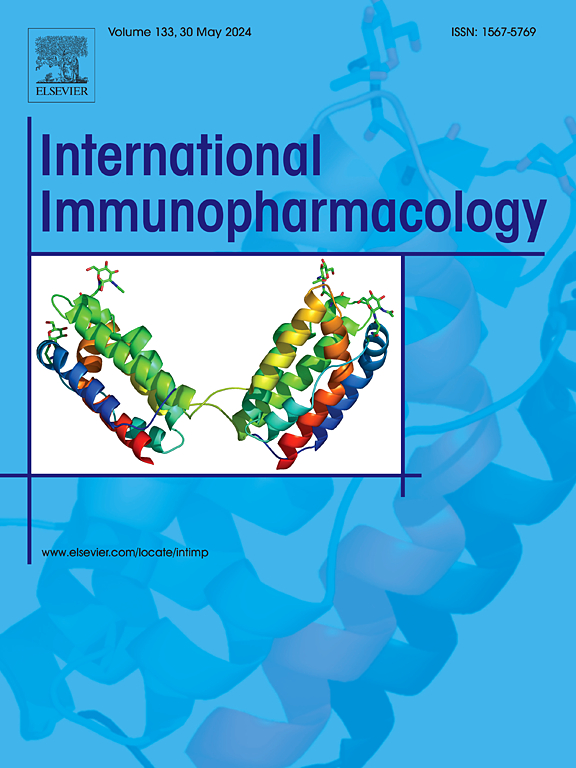雷马唑仑通过激活PI3K/AKT通路抑制急性肺损伤中内皮细胞和上皮细胞凋亡。
IF 4.8
2区 医学
Q2 IMMUNOLOGY
引用次数: 0
摘要
背景:急性肺损伤(ALI)和急性呼吸窘迫综合征(ARDS)是全球健康的重大负担。雷马唑仑(Remimazolam, REM)是一种新型的镇静剂,具有潜在的抗炎作用。然而,目前缺乏证据阻碍了我们确定REM是否可以改善ALI/ARDS。方法:我们在脂多糖(LPS)诱导的ALI小鼠模型中初步评估REM对肺损伤的影响。随后,利用网络药理学(NP)策略和核糖核酸测序(RNA-seq)技术研究REM对ALI作用的潜在分子机制。最后,我们进行了体内和体外实验来验证我们对这些机制的发现。结果:快速眼动可有效减轻小鼠肺损伤。NP和RNA-seq分析显示凋亡相关通路显著富集。体内和体外实验均显示,REM显著降低了肺组织、内皮细胞和上皮细胞中裂解型半胱氨酸-天冬氨酸特异性蛋白酶/蛋白酶7和蛋白酶3(裂解型caspase -7和-3)和细胞色素c (Cyt c)水平,同时提高了B细胞淋巴瘤2 (Bcl-2)/Bcl-2样蛋白4 (Bax)比率和磷酸化蛋白激酶B (P-AKT)水平。此外,体外实验证实LY294002抑制磷酸肌苷3-激酶(PI3K)/AKT通路减弱REM的抗凋亡作用。此外,在lps诱导的内皮细胞中,用PK11195 (18kda转运蛋白[TSPO]的配体)预处理可减弱REM对PI3K/AKT通路的上调和抗凋亡作用。结论:本研究提出了新的发现,阐明了快速眼动在急性脑损伤中的有益作用。这种作用可归因于REM通过激活内皮细胞和上皮细胞的PI3K/AKT通路抑制细胞凋亡的能力。此外,REM靶向TSPO调节内皮细胞的这一途径。这些结果提示REM在ALI/ARDS治疗中具有潜在的保护作用。本文章由计算机程序翻译,如有差异,请以英文原文为准。

Remimazolam inhibits apoptosis of endothelial and epithelial cells by activating the PI3K/AKT pathway in acute lung injury
Background
Acute lung injury (ALI) and acute respiratory distress syndrome (ARDS) are significant burdens on global health. Remimazolam (REM), a novel sedative, has shown potential in its anti-inflammatory effects. However, a lack of evidence currently hinders our ability to determine if REM can improve ALI/ARDS.
Methods
We initially evaluated REM’s impact on lung injury in a lipopolysaccharide (LPS)–induced ALI mouse model. Subsequently, a network pharmacology (NP) strategy and ribonucleic acid–sequencing (RNA-seq) technique were used to investigate the potential molecular mechanisms underlying REM’s action against ALI. Finally, we carried out in vivo and in vitro experiments to validate our findings on these mechanisms.
Results
REM effectively mitigated lung injury in the mouse model. NP and RNA-seq analyses revealed significant enrichment of apoptosis-related pathways. Both in vivo and in vitro experiments revealed that REM significantly reduced levels of cleaved cysteine–aspartic acid–specific protease/proteinases 7 and 3 (cleaved Caspases-7 and −3) and cytochrome c (Cyt c) while enhancing the B-cell lymphoma 2 (Bcl-2)/Bcl-2–like protein 4 (Bax) ratio and phosphorylated protein kinase B (P-AKT) levels in lung tissue, endothelial cells, and epithelial cells. Furthermore, in vitro experiments confirmed that inhibiting the phosphoinositide 3-kinase (PI3K)/AKT pathway with LY294002 weakened REM’s antiapoptotic effects. In addition, pretreatment with PK11195 (the ligand of 18-kDa translocator protein [TSPO]) attenuated REM’s upregulation of the PI3K/AKT pathway and antiapoptotic effect in LPS-induced endothelial cells.
Conclusions
This study presents novel findings elucidating the beneficial effect of REM in ALI. This effect can be attributed to REM’s ability to inhibit apoptosis by activating of the PI3K/AKT pathway in endothelial and epithelial cells. Additionally, REM targeted TSPO to regulate this pathway in endothelial cells. These results suggested a potential protective role for REM in ALI/ARDS management.
求助全文
通过发布文献求助,成功后即可免费获取论文全文。
去求助
来源期刊
CiteScore
8.40
自引率
3.60%
发文量
935
审稿时长
53 days
期刊介绍:
International Immunopharmacology is the primary vehicle for the publication of original research papers pertinent to the overlapping areas of immunology, pharmacology, cytokine biology, immunotherapy, immunopathology and immunotoxicology. Review articles that encompass these subjects are also welcome.
The subject material appropriate for submission includes:
• Clinical studies employing immunotherapy of any type including the use of: bacterial and chemical agents; thymic hormones, interferon, lymphokines, etc., in transplantation and diseases such as cancer, immunodeficiency, chronic infection and allergic, inflammatory or autoimmune disorders.
• Studies on the mechanisms of action of these agents for specific parameters of immune competence as well as the overall clinical state.
• Pre-clinical animal studies and in vitro studies on mechanisms of action with immunopotentiators, immunomodulators, immunoadjuvants and other pharmacological agents active on cells participating in immune or allergic responses.
• Pharmacological compounds, microbial products and toxicological agents that affect the lymphoid system, and their mechanisms of action.
• Agents that activate genes or modify transcription and translation within the immune response.
• Substances activated, generated, or released through immunologic or related pathways that are pharmacologically active.
• Production, function and regulation of cytokines and their receptors.
• Classical pharmacological studies on the effects of chemokines and bioactive factors released during immunological reactions.

 求助内容:
求助内容: 应助结果提醒方式:
应助结果提醒方式:


